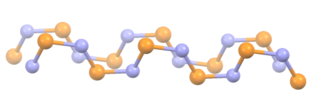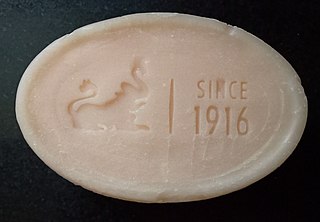The Bischler–Möhlau indole synthesis, also often referred to as the Bischler indole synthesis, is a chemical reaction that forms a 2-aryl-indole from an α-bromo-acetophenone and excess aniline; it is named after August Bischler and Richard Möhlau .

Polythiazyl, (SN)x, is an electrically conductive, gold- or bronze-colored polymer with metallic luster. It was the first conductive inorganic polymer discovered and was also found to be a superconductor at very low temperatures. It is a fibrous solid, described as "lustrous golden on the faces and dark blue-black", depending on the orientation of the sample. It is air stable and insoluble in all solvents.

The Thorpe–Ingold effect, gem-dimethyl effect, or angle compression is an effect observed in chemistry where increasing steric hindrance favours ring closure and intramolecular reactions. The effect was first reported by Beesley, Thorpe, and Ingold in 1915 as part of a study of cyclization reactions. It has since been generalized to many areas of chemistry.
The Thorpe reaction is a chemical reaction described as a self-condensation of aliphatic nitriles catalyzed by base to form enamines. The reaction was discovered by Jocelyn Field Thorpe.

Hydrastine is an isoquinoline alkaloid which was discovered in 1851 by Alfred P. Durand. Hydrolysis of hydrastine yields hydrastinine, which was patented by Bayer as a haemostatic drug during the 1910s. It is present in Hydrastis canadensis and other plants of the family Ranunculaceae.

Sobrerol is a mucolytic.
The Cook–Heilbron thiazole synthesis highlights the formation of 5-aminothiazoles through the chemical reaction of α-aminonitriles or aminocyanoacetates with dithioacids, carbon disulphide, carbon oxysulfide, or isothiocyanates at room temperature and under mild or aqueous conditions. Variation of substituents at the 2nd and 4th position of the thiazole is introduced by selecting different combinations of starting reagents.

Sir Jocelyn Field Thorpe FRS was a British chemist who made major contributions to organic chemistry, including the Thorpe-Ingold effect and three named reactions.
Mildred May Gostling, also published under her married name Mildred Mills, was an English chemist who completed research in carbohydrate chemistry. She was one of the nineteen signatories on a letter from professional female chemists to the Chemical Society requesting that women be accepted as Fellows to the Society.
Dorothy Norris née Harrop (?-?) was an English biochemist who worked on yeast fermentation, protein chemistry, and was a pioneer in the study of carcinogens. She moved to India where she worked at the Indian Institute of Science before becoming the founding director of the Indian Lac Research Institute at Ranchi.
Isabel Ellie Knaggs was a Colony of Natal born crystallographer. She was educated and worked in the UK. She worked with Kathleen Lonsdale on the crystal structure of benzil.

16-Methylene-17α-hydroxyprogesterone acetate is a progestin of the 17α-hydroxyprogesterone group which was never marketed. Given orally, it shows about 2.5-fold the progestogenic activity of parenteral progesterone in animal bioassays. It is a parent compound of the following clinically used progestins:
George Gerald Henderson was a chemist and professor at the University of Glasgow. He was known for his work on terpenes.
Charles Rugeley Bury was an English physical chemist who proposed an early model of the atom with the arrangement of electrons, which explained their chemical properties, alongside the more dominant model of Niels Bohr. In some early papers, the model was called the "Bohr-Bury Atom". He introduced the word transition to describe the elements now known as transition metals or transition elements.

Sosale Garalapury Sastry was an Indian industrial chemist known for his work on the manufacture of sandalwood soap through the establishment of the Mysore soap factory in Bangalore. This earned him the nickname of Soap Sastry. He also served as a director of industries and commerce in Mysore State.

Walthère Victor Spring was a Belgian experimental chemist and a professor at the University of Liège who contributed to ideas on carbon dioxide in the atmosphere and the Greenhouse Effect. As a physical chemist he demonstrated the formation of certain compounds such as metal sulphides under high pressure conditions. He also took an interest in the study of the Tyndall effect and examined the cause of the colour of the sky and water.

Andreas Smits was Dutch chemist who specialized in physical and inorganic chemistry and examined aspects of phase change and conversions between allotropic forms. He was a professor at the Delft University of Technology.
John Albert Newton Friend was a British chemist and educator who specialized in the chemistry of corrosion and its prevention. He was among the first to note that chromium enhances the corrosion resistance of steel. He edited a multi-volume textbook of inorganic chemistry.
Agnes Marion Moodie was a Scottish chemist and the first female chemistry graduate from the University of St Andrews.








